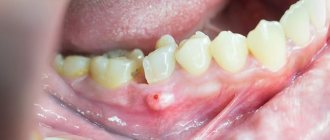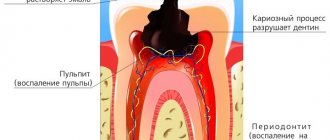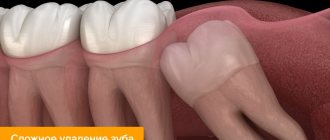Many people are familiar with the phenomenon of gumboil - when the cheek next to a sore tooth swells literally before our eyes and painkillers do not relieve acute pain. This is the periosteum of the tooth becoming inflamed, or, as doctors say, odontogenic periostitis of the jaws has developed. This disease in itself is a complication of dental problems (periodontitis, periodontitis), but in the absence of proper treatment, such inflammation can also cause the development of even more serious complications.
Why can the periosteum of a tooth become inflamed?
The most common is odontogenic periostitis of the jaws, that is, an inflammatory process provoked by diseases of the teeth or periodontal tissues. Deep caries, pulpitis, periodontitis (inflammatory process at the apex of the tooth root), periodontitis - all these diseases, if not treated in time, lead to the appearance of gumboil. Also, one of the reasons for the development of the inflammatory process may be alveolitis - inflammation of the tooth socket, which in some cases occurs after tooth extraction. Inflammation of the periosteum after tooth extraction usually develops in those patients who do not rush to see a dentist when the first signs of complications appear in the postoperative period.
Much less common is toxic periostitis, caused by infection through the blood or lymph (usually due to some general infectious disease). The disease can also be caused by injuries to the jaw bone or surrounding soft tissue.
Inflammation of the periosteum of the tooth: symptoms
Depending on the form and localization of the process, symptoms may be as follows:
- General symptoms: severe pain in the area of inflammation, swelling, noticeable swelling, discoloration of the gums, mobility of the dental unit, which served as a source of spread of the pathological process. Depending on the location of the source of infection, facial swelling will look different: when inflammation develops near the front teeth, the upper lip or middle third of the face swells; when inflammation occurs near the chewing teeth, the cheek, sometimes the lower eyelid, and parotid area swell. You can evaluate what different types of edema look like during inflammation of the periosteum of the tooth using a photo.
- Acute serous periostitis of the lower or upper jaw is accompanied by severe redness of the mucous membranes, rapid development of edema, and increased body temperature. The general symptoms of this form of inflammation are especially pronounced.
- In the acute purulent form of the disease, severe sharp pain is characteristic, and the pain subsides under the influence of cold and becomes stronger when exposed to heat. Sleep and appetite are disturbed, the temperature rises noticeably, and the patient’s general condition worsens. Pain in most cases radiates along the branches of the corresponding nerves. For example, acute purulent periostitis of the lower jaw can make itself felt by pain in the neck, chin, ear and temporomandibular joint. Purulent periostitis of the upper jaw most often provokes pain in the orbital area, temporal bone, and ear.
- The chronic form of the disease is quite rare, and chronic periostitis of the lower jaw usually develops. The symptoms are mild, the swelling is almost unnoticeable and can gradually develop over a very long time. Pain and discomfort appear from time to time (periods of exacerbation).
At the initial stage of the inflammatory process, it usually has a serous form, later, without treatment, it becomes purulent. With a large accumulation of pus, the formed abscess can burst with the flow of purulent contents into the oral cavity. At the same time, the swelling decreases and the pain subsides. In this case, some patients calm down, believing that the problem has been solved, and are in no hurry to see a dentist. In fact, this is only temporary relief, since the pathological process can resume at any minute.
Causes of pain in the gums
Constant pain when pressing on the gums makes it difficult to eat and negatively affects a person’s psycho-emotional state. The symptom may occur regularly or occur periodically without any complications. This signal from the body should not be ignored, since in the future the pain above the gum may be complicated by more serious processes.
Carious tooth decay
Pain occurs in advanced forms of caries, when there is a destroyed cavity or pulpitis. In the first case, unpleasant symptoms quickly disappear. With pulpitis, the symptom is permanent and manifests itself more clearly. In such a situation, the patient needs urgent treatment or removal of the damaged element.
Periodontitis
The disease develops as a result of untreated caries. The disease is characterized by sore gums, general deterioration of well-being and elevation of the problem unit. After the death of the nerve, the tooth temporarily ceases to feel pain. Periodontitis threatens the spread of infection throughout the body.
Periodontitis is inflammation of the tooth root
Gum hypersensitivity
Pain occurs with pressure and disappears a few seconds after mechanical action on the tissue. Patients with hypersensitivity are prescribed special dental care products and diet.
Dental treatment
Pain in the gum above the tooth can be observed both with unskilled and competent dental work. In the latter case, the symptoms of discomfort disappear after 2-3 days. The patient can help reduce the intensity of symptoms by rinsing with saline solutions, taking painkillers and thoroughly cleaning the mouth.
If therapy is unsuccessful, pain occurs due to:
- Poor finishing of the filling. The symptom appears immediately after installation of the filling material. A person experiences discomfort when closing teeth and eating food. Significant pain is caused by pressing on the gum above the tooth. The patient should inform the dentist about any discomfort while in the chair. Otherwise, you will have to see a doctor again to have the filling trimmed.
- Untreated caries. The problem most often occurs due to incomplete cleaning of carious cavities by the dentist. Pain under the tooth occurs 2-3 months after treatment. Before secondary treatment of caries, a person is prescribed an x-ray to assess the complexity of the situation.
- Poor quality canal filling. The situation in the future may be complicated by a cyst or periodontitis. Trying to deal with pain on your own will not work.
See a doctor immediately if pain in the gums when pressed is accompanied by dangerous signs - fever, swollen lymph nodes, weakness and swelling of the cheeks
Periostitis in children
In children, the inflammatory process usually develops as a result of untreated caries of baby teeth, infectious diseases or injuries. Due to the peculiarities of the physiology and anatomy of the child’s body, as well as due to the immaturity of the child’s immune system, the pathology develops quickly and rapidly, and the infection quickly spreads through the bloodstream and lymph flow, so multiple lesions can form.
Periostitis of the upper jaw in a child requires special attention, which, when localized in the palate, may not change facial features - swelling forms inside the oral cavity and can only be noticed by the characteristic convex swelling on the palate. The abscess gradually grows, capturing the mucous areas of the pharynx and tongue, which causes pain when swallowing and chewing. If a child develops symptoms such as fever, loss of appetite, or painful swallowing, it is imperative to check whether such a condition is caused by developing gumboil.
Possible complications and diagnosis
If the disease is not treated properly, very serious complications soon develop: osteomyelitis (purulent inflammation of bone tissue, provoking its necrosis), phlegmon (a diffuse purulent process that affects nearby tissues and requires immediate surgical intervention), sepsis (a general infection of the body, often ending in the death of the patient ). Each of these conditions requires emergency medical care and long, painstaking treatment. Therefore, it is better not to let the situation lead to complications and contact a dentist at the first signs of an inflammatory process.
To establish an accurate diagnosis, the doctor will need to conduct a differential diagnosis using instrumental diagnostic methods (radiography, CT). This disease is similar in symptoms to acute periodontitis, acute inflammation of the salivary glands, lymphadenitis, and osteomyelitis. Therefore, in order to prescribe adequate treatment, it will be necessary to exclude these conditions and accurately determine the cause of the patient’s poor health.
What does pulsation in the gums indicate?
If something is pulsating in the gum, and it is swollen and painful, this is a direct signal that inflammatory processes are spreading in the mucous membrane. As part of the diagnosis, the doctor takes into account the nature, strength and frequency of attacks, after which, based on the information received, he makes a diagnosis. In addition to the fact that such a situation can be caused by injury to soft tissues and penetration of infection into the mucosa, such a symptom often becomes a consequence of the development of the following pathological processes:
- carious destruction: in moderate and deep forms, the patient may experience short-term attacks of pulsating pain, which are especially acute under the influence of external stimuli - excessively salty or sweet foods, cold or hot foods and drinks,
- acute pulpitis: this disease usually follows the late stage of caries, when harmful microorganisms penetrate deep into the dental tissues and reach the pulp, causing severe inflammation and severe pain. The pain is especially pronounced at night,
The photo shows tooth pulpitis - acute form of periodontitis: characterized by the development of inflammation at the apex of the root, which may be caused by untreated pulpitis or poorly performed filling of the tooth canals. In this case, a purulent abscess forms at the root.
“My husband had a terrible toothache about a month ago. He jumped up in the middle of the night as if scalded, he said he felt a pulsation. It turns out that his wisdom tooth had come out and a purulent abscess had formed, causing terrible pain. But this was already explained to us in dentistry. They cut my husband’s gums, cleaned everything thoroughly, prescribed antibiotics and rinses. Everything happened in just 3 days. But it’s better, of course, not to let it come to that. If you experience any discomfort, immediately run to the doctor!”
Liliya, 27 years old, Moscow, from correspondence on the woman.ru forum
And these are just the most commonly diagnosed diseases with throbbing pain in the gum tissue. There are many different reasons that can trigger the appearance of this symptom. Only a dentist can determine the true cause of the problem after carrying out the necessary diagnostic procedures.
Inflammation of the periosteum of the tooth: treatment
Periostitis of the lower and upper jaw requires almost the same treatment, despite some differences in symptoms and localization of lesions. Moreover, complex therapy will be required, which will quickly eliminate the infectious-inflammatory focus and prevent relapses:
- Surgery. Opening the purulent sac with removal of the contents and thorough cleaning of residual pus is a mandatory procedure in this case. The intervention is performed under local anesthesia. At the initial stage of the disease (with its serous form), it is possible to do without surgical intervention. In this case, the doctor carries out endodontic treatment (depulpation, cleaning and treatment of root canals, antibacterial therapy).
- Drug therapy. Prescribing antibacterial and anti-inflammatory drugs to eliminate inflammatory phenomena (swelling, hyperemia, fever, pain) and infection.
- Physiotherapeutic procedures. Iontophoresis, ultrasound or laser therapy, electrophoresis, paraffin therapy - all these procedures are usually aimed at resolving compactions formed as a result of the pathological process. As a rule, physiotherapy is used for chronic forms of the disease, but in some cases it can be used in the complex treatment of acute purulent forms.
Antibiotics for inflammation of the periosteum of the tooth are prescribed during the treatment process; they are necessary to eliminate the bacterial infection, which is one of the causes of the development of the purulent-inflammatory process. The doctor selects medications based on the severity of the disease, the general condition of the patient’s body and the possible presence of concomitant diseases. Along with antibiotics for periostitis of the jaw, antihistamines (antiallergic) are also prescribed as treatment, which can reduce the drug load on the immune system, as well as calcium supplements.
The success of treatment largely depends on the patient’s timely visit to the doctor and the effectiveness of the therapy itself. And if in the first case everything depends on the patient - his conscious attitude towards his own health, then in the second the success of treatment is completely determined by the qualifications and experience of the dentist to whom the patient turned. A competent specialist with extensive clinical experience will quickly and successfully cope with even such a complex disease, while an amateur can further aggravate the problem. Therefore, choosing a good specialist is important here - these are the specialists who work at the 32 Dent clinic. Our doctors have extensive experience in successfully treating any purulent-inflammatory diseases of the oral cavity, including periostitis.
Treatment in dentistry
Diagnosis and treatment of oral diseases is the prerogative of the dentist. Homemade decoctions and infusions are certainly effective, but in the early stages of illnesses. And when the pathology has gone far, only a doctor can correctly draw up a program. The range of technologies and tools is quite extensive. Firstly, hygienic hardware cleaning, which removes plaque. It can be ultrasonic, sandblasting and laser. Special systems are capable of providing deep cleaning of periodontal pockets. Dental scalers are used to treat many periodontal diseases. More information materials can be found here: “Periodontology in St. Petersburg”.
Gingivitis can be treated well with modern ointments and gels: Cholisal, Kamistad, Asepta. Their active ingredients easily penetrate soft tissue, but do not touch bone. Sometimes epithelializing agents are prescribed - Actovegin, Solcoseryl. If there are no acute processes or purulent discharge, a medical current is applied to the affected areas, which normalizes blood circulation. Vacuum therapy is also used when an artificial hematoma is formed, for the resorption of which the protective forces are activated.
Curettage is recommended for curettage of deposits, as well as tissues that have pathologically changed. For deep pockets, closed curettage is performed using local anesthesia. If the situation is too complex, the procedure is performed openly, which involves cutting the gums. When therapeutic methods do not bring the desired result, the patient is referred to a maxillofacial surgeon. Basic technologies: implantation, placement of a membrane to stimulate tissue repair. Both gingivectomy and flap operations are used.
It is important to choose the right clinic with a high level of staff training, modern technical equipment, and readiness to provide medical care in emergency cases. And there is such a center - this is ARTE-S. We are always ready to help you!
How to treat inflammation of the periosteum of a tooth before visiting a doctor?
Self-medication for any purulent processes is very dangerous, so it is recommended to consult a dentist at the first symptoms of the disease. However, before visiting a doctor, the patient can alleviate his condition somewhat by applying cold to the cheek on the affected side and rinsing his mouth with an antiseptic solution at room temperature (chlorhexidine soda-saline solution, chamomile or sage decoctions). Here's what you absolutely can't do:
- Apply warm compresses and drink hot drinks.
- Apply any bandages yourself or use medications without a doctor’s prescription.
- It is better not to take analgesics before visiting the dentist.
- If you are undergoing surgery (opening an abscess), you should not take aspirin, since it changes the rheological properties of the blood and can cause bleeding.










